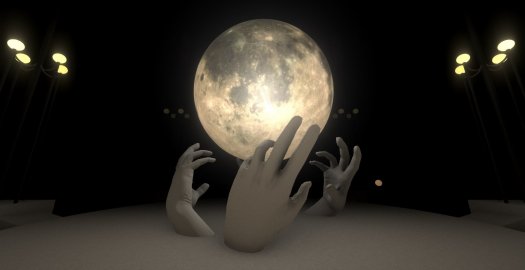Review for There Was the Moon

A tower stands before you, its façade crisscrossed by stairs that patiently await your ascent. Earth’s moon, abnormally large, barely illuminates the dark water lapping either side of the path that beckons you ahead. Despite feeling anxious, you must proceed, for you have been chosen to bring the ceaseless night to an end.
Thus begins There Was the Moon, a short, surreal sci-fi puzzle game by Ben Lapid that intrigues and unsettles in nearly equal measure, with bizarre visuals and haunting soundscapes bombarding you at nearly every turn. Although the strange alien locales and mysterious narrative headline the experience, the few logic puzzles scattered throughout provide a mild challenge for those looking to flex their problem-solving muscles. While the pair of endings on offer could have been more emotionally impactful to more suitably cap this fascinating journey, this is mostly nitpicking in an unheralded little indie game that deserves to be experienced.
Like most surrealist art, There Was the Moon’s story is rather obtuse, but the basic premise is outlined in the main menu’s “About” option: Following hostile first contact with a race of powerful beings called the Divine, an interspecies peace treaty known as the Pact decreed that humanity would endure under a curse of eternal night, with the moon fixed in the sky. Ages pass until you, the “Chosen,” are sent to complete a ritual in accordance with the Pact that is intended to lift the curse.
Shortly after reaching the tower where your adventure begins, the first object you interact with is a monolithic device that presents stanzas of poetry on-screen when activated. You will occasionally encounter similar devices throughout the game, and while their evocative bits of verbiage are vague, each usually seems to relate to the task at hand or appears to reveal something about the Divine and their relationship with humanity. I am not particularly equipped to evaluate its poetic merits, but it certainly added to the mysterious air and the sense that I was embarking on a journey that I was not fully prepared to understand.
While you will undertake a variety of tasks over the course of the game, such as performing a cleansing ritual to prepare yourself for what is ahead, driving a dagger into a glowing egg, and collecting a bowl with leaves gathered from a special tree, ultimately the exact nature of the ritual is up to you to deduce. Although you spend the vast majority of your time in solitude, there are three unusual characters that you’ll meet along the way (including a glowing face that looms out of a wall when you approach) who have their own contributions to make to your understanding of the ritual, including questioning whether it is for the benefit or detriment of humanity.
Some players may find the deliberately opaque narrative frustrating, but I found it quite compelling, simply because it is so strange that I couldn’t help but continually theorize what it all meant. That said, the endings are fairly unambiguous, and there appear to be two, though the second is available only if you’ve completed an optional objective earlier on (more on this shortly). If you have, an autosave will record your progress right before a fateful decision late in the game, allowing you to easily go back and reload to see the alternate outcome if you wish. My only real complaint regarding these finales is that they are both somewhat abrupt and, aside from the consequences for the story, don’t feel different enough from one another in terms of the way they play out to be truly satisfying. Thankfully, this doesn’t detract from what came before it in retrospect, but a more effective emotional impact would have been in keeping with the rest of the experience to that point.
It’s not meant to be a horror game, but There Was the Moon is an unnerving experience, thanks in large part to a copious amount of trippy, awe-inspiring graphics. Whereas other first-person adventures like Myst tend to retain some semblance of familiarity and naturalism that allows players to feel at ease even when the surroundings are quite haunting, I spent practically my entire playthrough of this game on edge because there is such an unsteadying, and sometimes outright menacing, air to much of what I encountered.
The game relies heavily on stark aesthetics to provoke a fundamentally emotional response. It’s something like a visual tone-poem, with glowing geometric shapes floating in midair; vast black space dotted with perfectly aligned rows and columns of lights, walls that fold in on themselves in a manner reminiscent of Inception, and spaces covered in shifting kaleidoscopic colors. You will discover tunnels with lighted walls that rotate hypnotically, a glowing red chamber complete with a disembodied hand sticking out of the wall to offer you a golden dagger, and an M. C. Escher-styled conglomeration of glowing beams floating in pitch-black space, amongst which you must walk to reach your destination as a transparent dragon-like creature flies overhead.
A quick note here: because of repeating patterns of light, shadow, and colors at various points, There Was the Moon will likely be an issue for those with photosensitive conditions. One sequence in particular, which I can only describe as a warp tunnel in which bright light on the walls around you moves front to back continuously and very rapidly, was especially dizzying for me even without having a medical condition like epilepsy.
Each major location is partitioned off by a door or lift that, once activated, allows access to the next area following a brief loading message. Honestly, although I found myself captivated by the game, I was often filled with dread at what I might find on the other side of the loading screen. Though nothing directly threatening ever materialized, the sense of impending danger never really went away, often heightened by the mysterious ambient soundtrack and a surprisingly artful use of audio effects.
Indeed, the places you explore are replete with ambient audio, showing impressive sound design for an indie production. For instance, a large tiled bathing room echoes convincingly with dripping water; distant, unseen bells ring heavily across a vast courtyard; and some locales feature unintelligible whispers, as though unseen spectators are commenting on your progress, or perhaps restless spirits are complaining about being disturbed. Character voices (if they can generously be termed such) consist of pops, clicks, and rattles that are appropriately alien, as well as labored breathing for one character that is very disquieting. Without warning, a few loud noises that sounded something like metallic moaning startled me by intruding on otherwise quiet moments. Though such mild jump scares are few and far between, they add welcome tension to the already disconcerting atmosphere.
There Was the Moon is controlled using the mouse and keyboard, with the ability to freely explore each 3D location. Your progress is saved automatically when entering a new area or after picking up an item. Various environmental objects can be interacted with, such as switches and buttons, and certain things can be collected as inventory, which is accessed via the escape menu. You can click on each item there, which loads a small textbox describing what you’ve found.
Acquired items are automatically used when you interact with the correct object, such as placing a token in a particular slot. Because of this streamlined mechanic, there aren’t really any inventory puzzles as such. Even if I didn’t know an object’s immediate use when I happened across it, the game took care of it for me so it was never an issue. This makes the bizarre variety of tasks that must be completed rather automatic and effortless, which keeps the pace moving along but made me feel like a spectator to much of what was going on. This didn’t especially bother me, but some more interactivity in this regard would have been appreciated.
There is one optional task involving the collection of a set of hidden items that one of the characters requests (actually a disembodied voice, but no matter) when you speak to her, which unlocks one of the endings when completed. On my first playthrough I had missed a couple of objects in question prior to encountering this character, and though I opted not to backtrack to retrieve what I’d overlooked before knowing it was there, once I knew what I should be looking for, I was able to complete this objective without difficulty the next time through and get the ending that was previously unobtainable.
Not every problem solves itself in There Was the Moon, as there are several logic puzzles as well. It is worth noting that the ability to distinguish color is part of the solution for a couple of them, so those with color blindness may have difficulty without assistance. For the most part these obstacles are fairly easy to overcome, whether matching patterns of lighted buttons to those on a nearby template, figuring out how to set various levers in place to retrieve items, or manipulating cube-shaped locks on a series of doors. The latter was the most elaborate and time-consuming of them all, but even for those fairly new to the genre it likely won’t provide a significant challenge. The lack of difficulty, however, shouldn’t be confused with poor design; the puzzles are actually quite elegant and fit well with the strange, mystical tone the game seeks to convey.
At around two hours long for the initial playthrough, There Was the Moon packs quite a memorable experience into a relatively brief package. Most notable is the relentlessly unsettling atmosphere that had me on edge the entire time. The story is quite abstract in execution but perfectly coupled with the disturbing environment, although the endings could have been more impactful. The gameplay challenge is minimal but the handful of logic puzzles are thoughtful and fit well with the overall conceit. All things considered, There Was the Moon is an unusual, beautiful, and surreal sci-fi experience that first-person adventure game fans will likely enjoy losing themselves in while it lasts. It isn’t a calming experience and has some minor drawbacks, but my biggest disappointment is simply that I can’t go back and play it for the first time all over again, and I suspect I won’t be alone.































